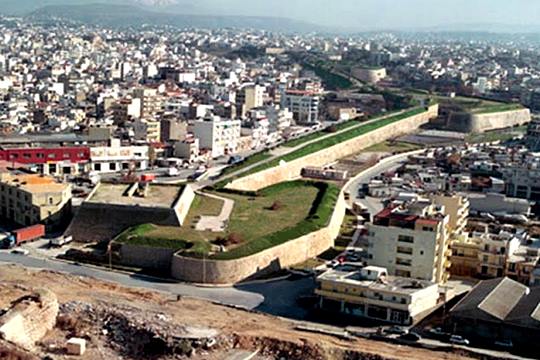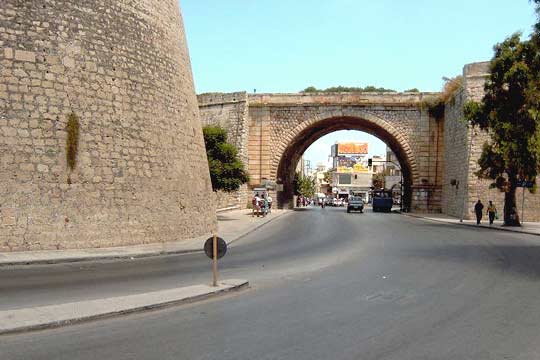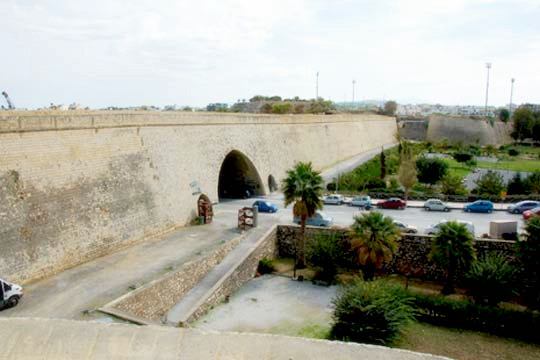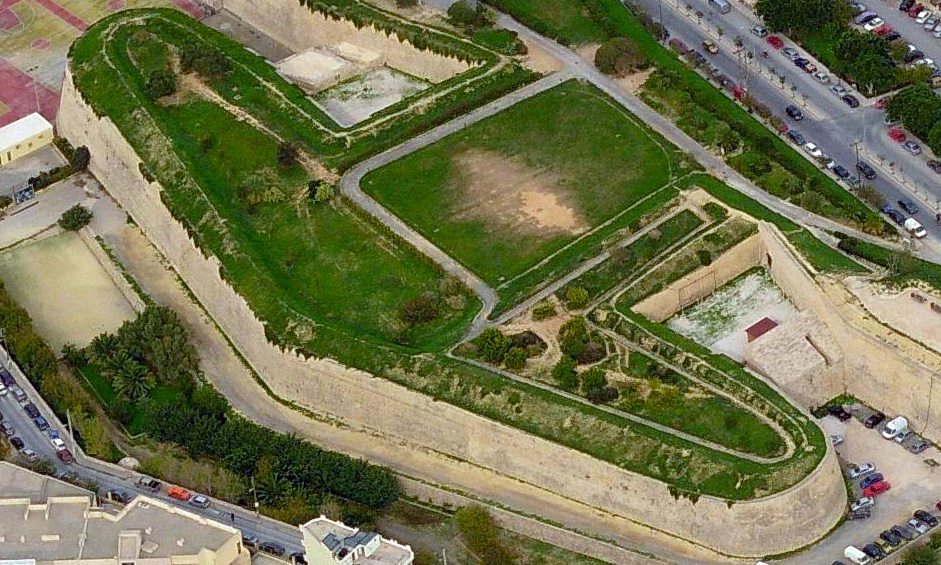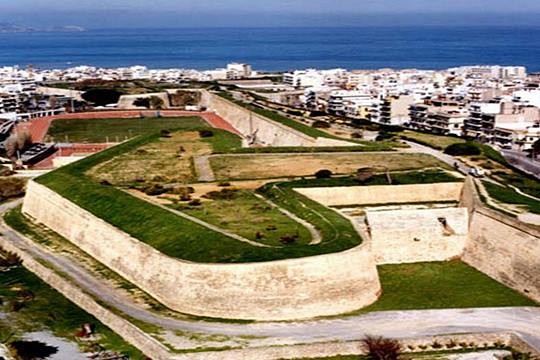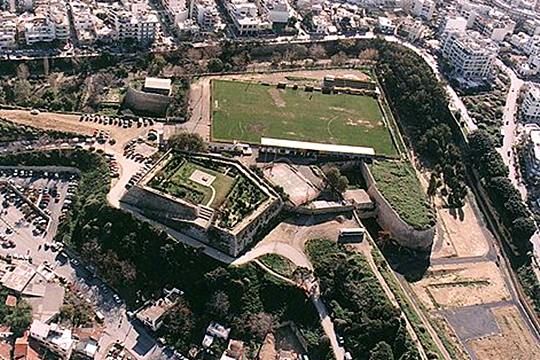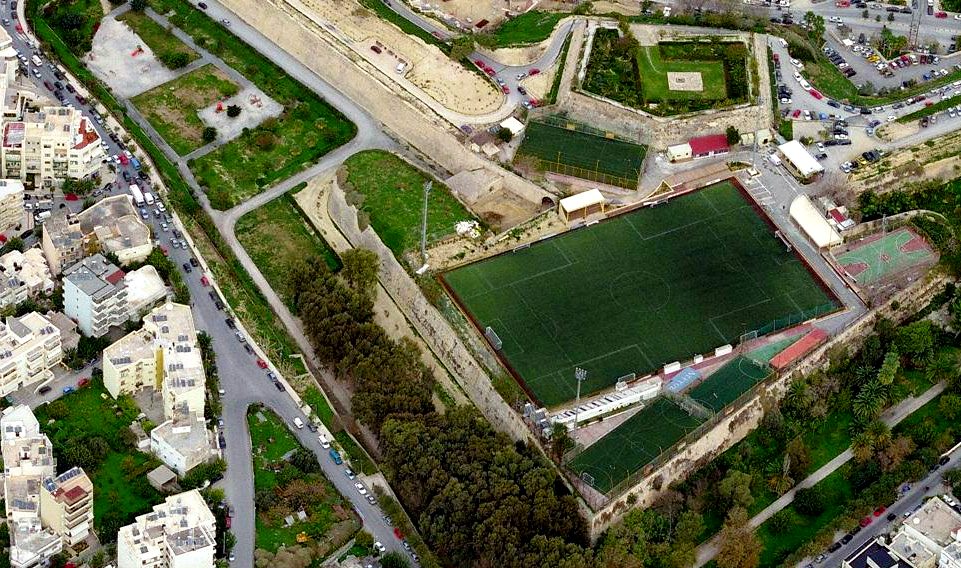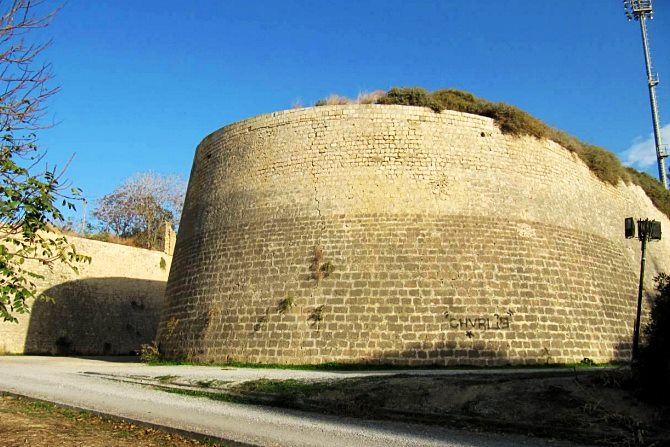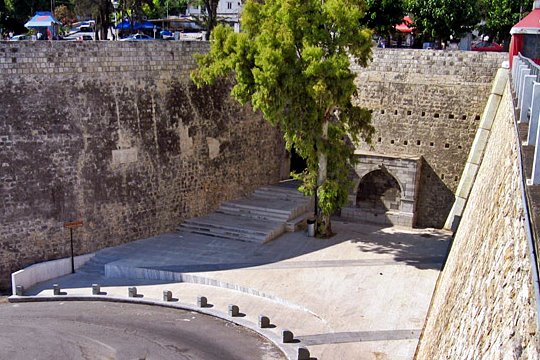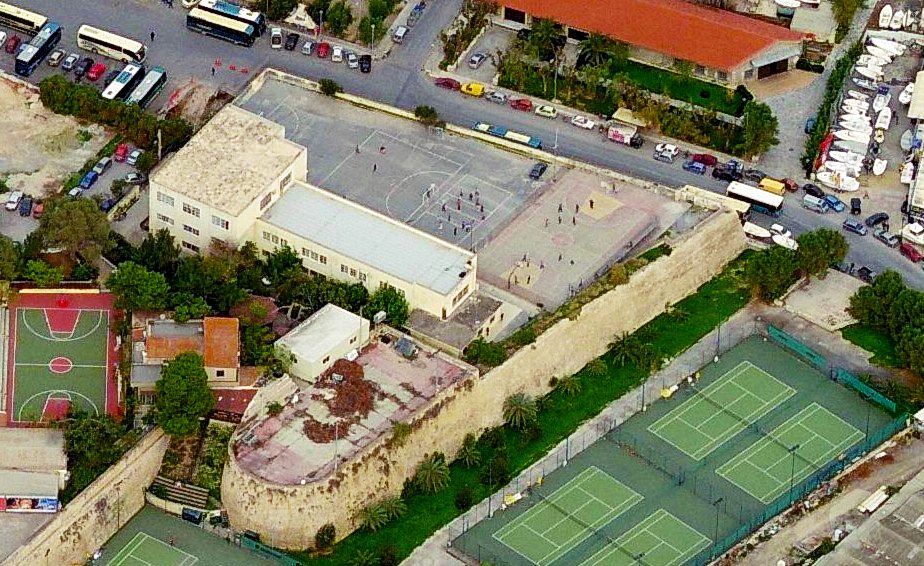Heracleion, Heraklion, Herakleion,Crete
Venetian Walls of Heraclion
| Location: |
| Heraclion, Crete |
| Region > Prefecture: | 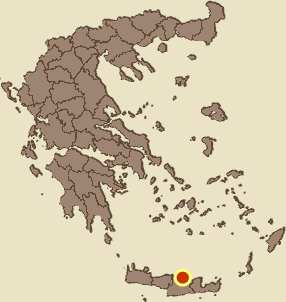 |
| Crete Herakleion | |
| Municipality > Town: | |
| City of Heraklion • Heracleion | |
| Altitude: | |
| Zero Altitude |
| Time of Construction | Origin | |
| 15th century | VENETIAN |
|
| Castle Type | Condition | |
| Fortress-state |
Relatively Good
|
The walls of the city of Heraclion are from the Venetian period of Crete. Their construction started in 1462 and lasted more than a century. This is the best preserved fortification of the 15th-16th century in the world and the best preserved fortification in the Mediterranean.
History
Heraclion existed with the same name since the beginning of the 1st millennium BC as a port of the Minoan city of Knossos.
During the first Byzantine period, before the conquest by the Arabs, the settlement still existed and was called Kastro (Castle), due to the fortification wall protecting it. Traces of the Byzantine wall have been found near the port of Heraklion.
In 824 AD the Byzantine Crete fell to the hands of Saracen Arabs leaded by Ambou Hafs Omar or Apochapsis. The capital of Crete, Gortys, was destroyed by them, as it was not seaside and did not serve the needs of the Saracen pirates. On the other hand, the small castle of Heraklion was ideal for to providing a new basis for their predatory raids in the Mediterranean.
After transferring the capital to Heraklion, the Saracens built a strong fortification. The wall was built of unbaked bricks, made of goat and pig hair. The wall was quite flat, so that it could fit two carriages. The outside side of the walls was protected by a deep ditch, which could be filled with sea water in one hour. Because of this trench, the Arabs called the city of Heraklion “Trench Castle” (Rabdh el Khantak), a name that was used for many centuries. This name became “Chandax” by the Byzantines and later “Candia” by the Venetians.
The Byzantines tried several times to recapture Crete without success, until 961AD general Nikephoros Phocas (later, emperor) managed to free the island. Fearing a possible return of the Arabs, Focas destroyed the fortifications, the ditch, and built the fortress Rokka in Kanli Castelli (today’s Prophet Elijah village).
Chandakas was shortly re-inhabited by Cretans and the Byzantines rebuilt new strong walls. After regaining Crete, the Byzantines were closely involved with the defense of the island, by building forts and castles all over the island. At the same time, they installed several soldiers coming from all over the Byzantine Empire to repel pirate attacks.
In 1206, after 2.5 centuries of Byzantine presence on the island, the Genoese, led by the Maltese Enrico Pescatore and his friend Alamanos da Costa occupied a large part of central Crete. Immediately, they fortified the big three castles of Candia, Sitia and Rethymnon and twelve smaller forts in several positions.
However, in the spring of 1209, the Venetians occupied the fort in Paliokastro (in Linoperamata area) and on May 1217 they managed to completely get rid of the Genoese. Thus, Crete became a Venetian possession for the next 4.5 centuries.
In the beginning, the Venetians used the Byzantine walls of Heraclion. But in the 15th century, they had to deal with some new facts: the Turkish threat after the fall of Constantinople had become eminent. Plus, the discovery of gunpowder and the use of cannons raised the need for stronger fortifications. Moreover, the population of the city had grown and those living outside the walls were 4 times more than those inside the castle.
The construction of the new walls (the current walls of Heraklion) began in 1462 and lasted more than a century. The initial projects were designed by the engineer Kampofregozo, but eventually the plans of the military engineer Michel Sammicheli were used.
The cost of construction funds were covered by Venice, the Kingdom of Crete, the Cretan people, the Church and the Jews. All Cretan men (14-60 years old) were forced to work for one week, every year, with their animals and without getting paid and fed. The building materials were transported from the quarries of Katsabas, Hersonisos and the ruins of Knossos Minoan Palace.
Structure, Fortification & Buildings
The triangular-shaped wall had its base on the coastal side and had an overall length of 3km. The moat, which was opened around it was very wide and deep, but there was never water in it. On the outer side of the trench, small forts were built called Revelini, to make it more difficult for enemies to approach the walls.
Gates
The castle had four main gates in four points:
On the north side, at the end of today’s August 25 Street, was the gate of Molos, which connected the town with the port.
In eastern side, near today’s statue of Eleftherios Venizelos, was the gate of St. George or Lazaretto, which connected Candia with Eastern Crete and with the quarantine hospital (lazaretto).
On the south side of the walls, in 1587, the Venetians built the gate of Jesus or New Gate (Kenourgia Porta). The roads starting from here led to the southern provinces of the county. Today's Kenourgia Porta bears no resemblance to the gate of that season.
On the west side, at the end of the square Strata was the Gate of Pantokratoras.Through this gate, the town communicated with Western Crete.
The three land gates of St. George, Jesus and Pantokratoras closed internally and externally, with very heavy and solid doors. The closing hours were at sunset and the opening at dawn. Those who stayed outside the walls, slept in special domed buildings for this purpose. The gates were protected by semicircular protrusions called Orecchione (large ears).
Besides the four main gates, there were still three more for military purposes. These were the gate of St Andrew (NW), the gate of Sand or Sabionera (BA) and the Gate of Dermatas leading to the homonym bay (located next to the Museum of Natural History). The last gate was built for the case of exclusion of the mouth of the main Venetian harbour. Near that gate, the volunteers of the Count De La Feuillades were bombarded by the Turkish army (Nov. 1668) and opened the way to occupy Candia. The gate is now located next to the municipal parking, opposite the Bodosakio Primary School.
Bastions
The walls were protected by seven bastions / ramparts. The bastion was a solid platform, which protruded from the walls, in order to protect a larger area and to support effectively the adjacent parts of the walls. The seven bastions of the walls of Heraklion are the following:
On the northeast corner, opposite the present hotel Atlantis, was the bastion of Sabionera (Sand), with the rampart Zane.
The southeastern corner (today Kapetanakio School) hosts the bastion Virouri with the homonym rampart.
The Gate of Jesus (now «Kenourgia Porta») was built on the bastion with the same name.
At the top of the triangular wall enclosure was the Martinengo Bastion (where the tomb of Nikos Kazantzakis is located). Martinengo is the largest bastion of Heraklion.
Opposite the hospital of Pananio, there is the bastion of Bethlehem.
Next to the Gate of Pantokratoras ( or «Chanioporta») was a bastion with the same name.
The northwest corner of the walls hosted the bastion of St. Andrew, the weakest of Candia.
To supplement the city's fortifications, the Venetians demolished the little old fortress at the harbor entrance and built the new fortress Rocca al mare (Sea Fort) within 17 years. This is the famous fort of Koules, which still dominates the old harbor.
The Turks conquered the Great Castle in 1669, after nearly 23 years of siege (May 29, 1648 - September 18, 1669), after the betrayal of the Venetian Andrea Barozzi entering from the bastion of San Andreas (St Andrew). The siege of the castle the longest recorded in world history.
| First entry in Kastrologos: | October 2012 | Last update of info and text: | November 2021 | Last addition of photo/video: | November 2021 |
Sources
- Γ. Ι. Χρηστάκης, "Ιστορικά Οχυρωματικά Μνημεία της Κρήτης (330πΧ-1898)", Εκδόσεις Κρητικά Γράμματα, 2004 (Greek only)
- Website CretanBeaches - The Castle of Candia (Heraklion)
- Website ΟΔΥΣΣΕΥΣ - Greek Ministry of Culture Ενετικά Τείχη Ηρακλείου (Greek only)
- ΑΡΧΑΙΟΛΟΓΙΚΟΝ ΔΕΛΤΙΟΝ τεύχος 27/Β2 (1972), σελ.663
|
|
| Access |
|---|
| Approach to the monument: |
| - |
| Entrance: |
| - |
| Timeline |
|---|
|
| Similar |
|---|
| Venetian Walls of Chania |



